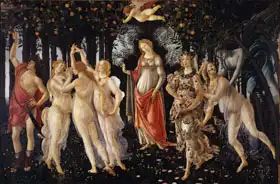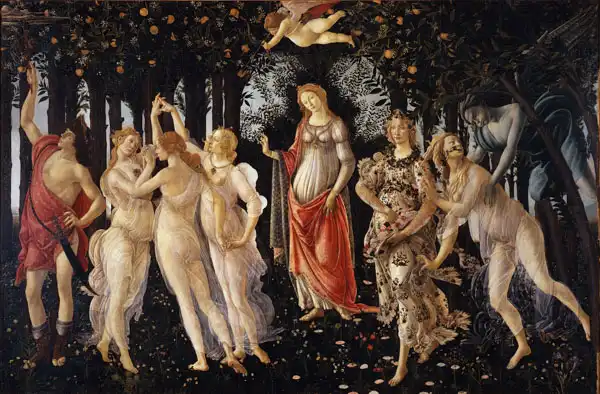About this finishing
Print. The image is printed on the top quality 10-ink HP Z9PS printer on HP matte 270 g / m2 paper. You can choose any size to an accuracy of 1 cm. A margin of 5 cm around the image is added to the size of the motif.


You can find a detailed description about our finishings
here.
Primavera
Date:
1478Medium:
tempera, woodLocation:
Galleria degli Uffizi, Florence, ItalyDimensions:
203 x 314One of the first paintings of the Renaissance working with ancient mythology. The image of Spring (Primavera) formed part of the cycle of the seasons. The nymph Chloris changes into Flora (symbol of spring) under the gust of the south wind (Zephyr). In the center is Venus with Cupid, the three graces and Mercury. The original painting from 1482 can be found in the Uffizi in Florence.
Botticelli painted picture Primavera in 1478. Prevailing color of this fine art print is vivid and its shape is landscape. Original size is 203 x 314. This art piece is located in Galleria degli Uffizi, Florence, Italy. This image is printed on demand - you can choose material, size and finishing.
Sandro Botticelli (1445-1510). Also known under the name Alessandro di Mariano di Vanni Filipepi. Botticelli was an Italian
Renaissance painter from the Florentine school. His work belongs to the best in the early Renaissance. Botticelli took his surname allegedly from his brother’s nickname (who was as rotund as a tub – botticelli). His artistic career likely began in the goldsmith’s workshop of his brother Antonio. Botticelli was later entrusted by his family to the care of Filippo Lippi, a renowned painter and knowledgeable monk. As a renowned artist, Botticelli gained friends and benefactors from the most important Florentine families. He worked mainly for the Medici family. In 1481, together with another major Florentine painter, Domenico Ghirlandaio, Botticelli was summoned to Rome to participate in the decoration of the Sistine Chapel. In 1491, they were both appointed to a jury that was to decide on the contract for the construction of the facade of Florence cathedral. At the end of his life, he evidently worked under the influence of Savonarol’s fiery sermons, exclusively painting Christian themes. Among his most famous works are
The Birth of Venus and
Spring (Primavera) . Botticelli never married – he reportedly struggled with unrequited love for Simonet Vespucci, who was to be the model for his Venus. As his dying wish, he desired to be buried at her feet. His wish was fulfilled.



